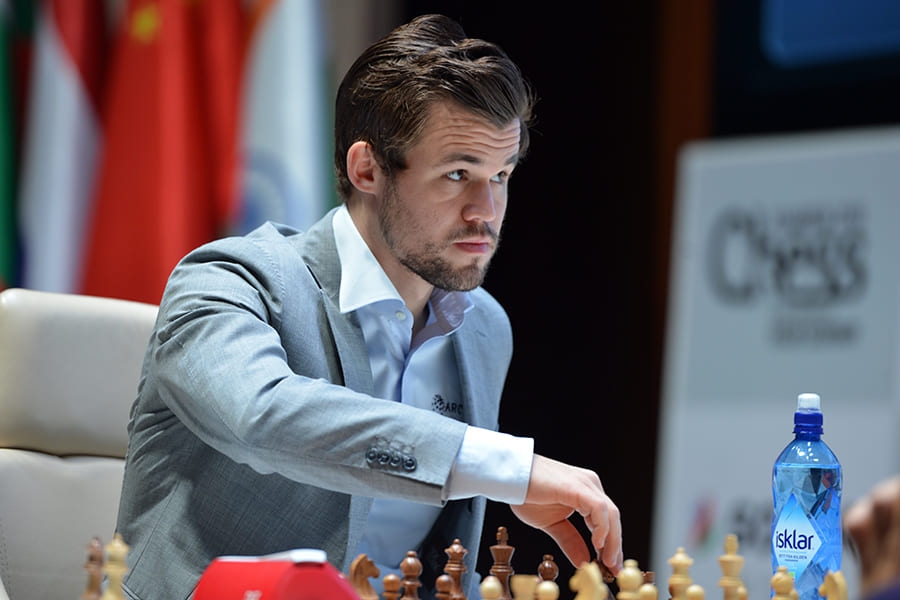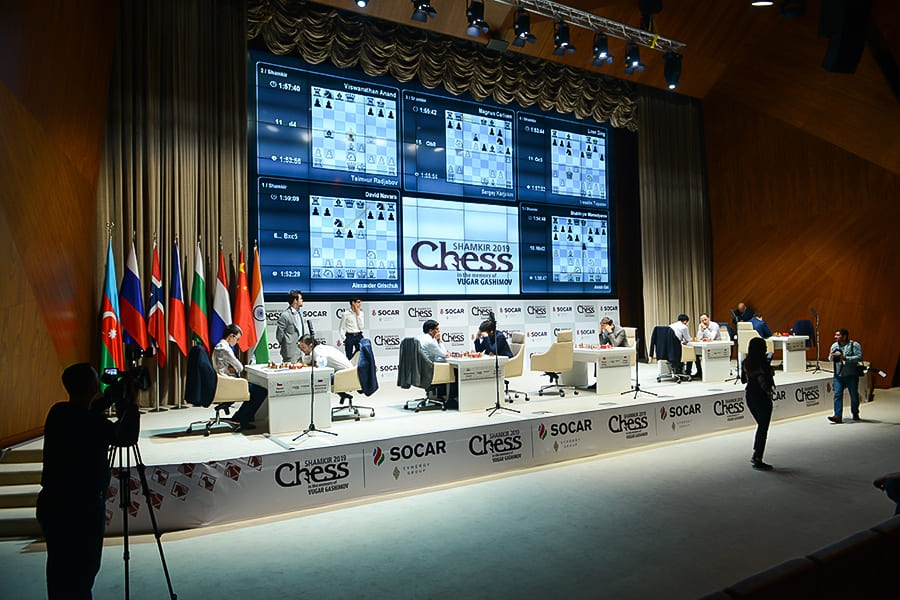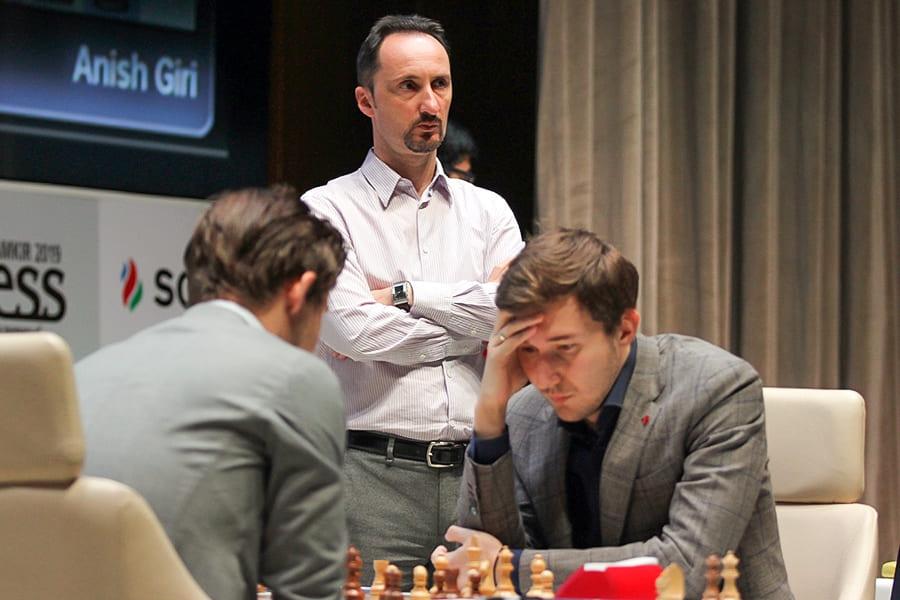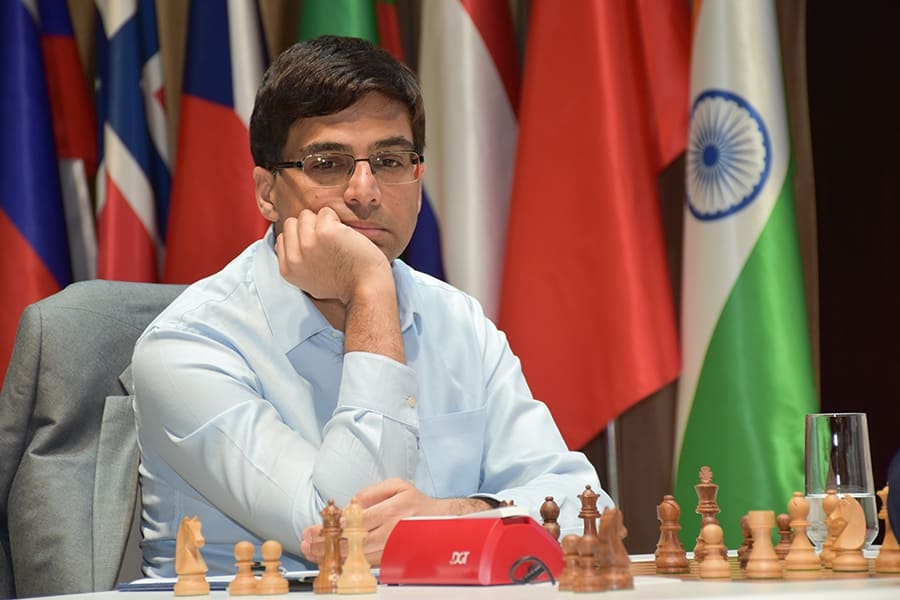


The highest-ever live rating was achieved by Magnus Carlsen on April 21st, 2014, after beating Shakhriyar Mamedyarov and Hikaru Nakamura in consecutive rounds at the first edition of the Gashimov Memorial. After winning that event, Carlsen would return a year later to once again finish atop the standings, this time with an astounding 7 out of 9 score and a 2981 performance rating. Finally, in 2018, he gathered six points to get his third win in Shamkir. And now he has done it again.
On Monday, Magnus defeated his only pursuer, Sergey Karjakin, to clinch first place with a round to spare. So far, he has gained 11.7 rating points in Shamkir, widening the gap that separates him from Fabiano Caruana to over forty points, after having put his first spot in danger prior to last year's World Championship match. Carlsen's final opponent will be Alexander Grischuk, and a win against the Russian will allow him to repeat his incredible 2015 '+5' performance.

Magnus' happy place | Photo: Official site
In the game, Sergey courageously accepted to test Carlsen's World Championship leftover preparation in the Sicilian Sveshnikov. On moves 10-13 it seemed like a triple repetition would lead to an anti-climatic end to the highly anticipated encounter. However, Karjakin kept things going by repeating Caruana's 14.h4, and then deviated from Fabiano's path with 15.♗g5:
Magnus responded with 15...♛b8 (15...♛d7 is also possible) and Sergey thought for 19 minutes before continuing 16.♗e2 — the former World Championship challenger was probably recalling his analysis.
Soon afterwards, Karjakin castled short, also taking a different path than the one Caruana chose in the crucial twelfth game of the London match, when the American castled long (by that time, there was a lot of talk about Fabiano being in a must-win situation, given Carlsen's superiority in rapid chess). After 20.0-0, White's h-pawn was under attack:

Sergey gave it all | Photo: Official site
Here Carlsen took his time before going 20...0-0, giving up a pawn for a second day in a row. After Sergey played 21.♗xh5, we knew we were in for a fight. Black had the initiative, and Magnus used it masterfully. By move 27, the pressure was mounting on White's position and his pieces were being expelled from the battlefield:
27...b4 and the knight is forced to sit on a4, while Black's queen and minor pieces can easily transfer to the kingside and control the centre. This kind of advantage in Carlsen's hands is perhaps insurmountable, but when Karjakin got a chance to alleviate the pressure he did not choose correctly which piece to exchange:
White should have captured the knight with 33.♗d3, but instead went for 33.♗g4 ♛xg4 34.♕xe4, exchanging the light-squared bishops. It is hard to criticize Sergey's decision, however, given the situation...A few moves later, the game was over, with all the positional trumps favouring Black:
No one can survive this with White, especially against the World Champion in top form!
.jpg)
Four out of four in Shamkir | Photo: Official site
Alexander Grischuk played the Advance Variation against David Navara's Caro-Kann and started thinking long and hard from move six. His efforts paid dividends, however, as he was the one pushing from the early middlegame. On move 17, the Czech grandmaster perhaps should have chosen a different knight to capture the pawn in order to get more of a fight:
Feel free to try your own variations on the diagram above
After 17...♞dxf6 White can attack the other knight with 18.h3 — it seems kind of sad to go back to h6, so Navara continued 18...♞xf2 and White is already clearly in the driver's seat. Perhaps what David missed in his calculations came only five moves later:
23.c5! is key for White, as after 23...♝xc5 he can fork rook and bishop with 24.♘xe4 — an easy move to miss from afar! From that point on Grischuk showed good technique until getting the full point after 40 moves.
.jpg)
This was Grischuk's second win of the event | Photo: Official site
The longest game of the day was Veselin Topalov vs Ding Liren. Most pieces were exchanged in the early middlegame and the players went into a double rook endgame with seven pawns per side. Shortly after the time control, two rooks had left the board and Ding Liren had a 4 v 3 advantage on the kingside, with a passed h-pawn to boot:
Black slowly but surely advanced his passer until forcing White to give up his rook and put all his hopes on the e-pawn:
After 73.♖xh2+ ♚xh2 White is only in time to promote to a knight:
As any basic endgame manual shows, White is forced to promote to a knight with check in this position, due to the mate threat created by the king and rook. But now White needs to defend a knight v rook endgame after having already fought for no less than 80 moves.
Veselin did manage to keep the computer evaluation around equal until move 95, when he moved his knight to a wrong square. Ding missed the right continuation two moves later...but then Topalov faltered again. The Chinese grandmaster did not miss his chance this time and forced the resignation of his opponent on move 110:
Black will play 110...♚g6 and the knight is lost. 0-1.
.jpg)
Ding Liren showed persistence to get the win | Photo: Official site
Teimour Radjabov signed his eighth draw of the tournament against Vishy Anand, while Anish Giri and Shakhriyar Mamedyarov did not avoid a triple repetition and left the tournament hall early with a half point each — an understandable decision given the fact that they have not fared well so far in Shamkir.

Vishy will play Topalov in round nine | Photo: Official site
Commentary by Evgeny Miroshnichenko